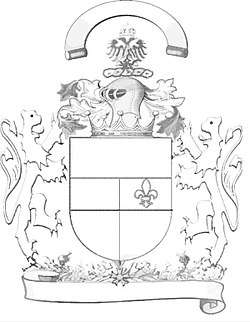Biscione
The biscione (Italian pronunciation: [biʃˈʃoːne]; Milanese: bissa [ˈbisa], plural: "biscioni"), also known as "the vipera" ([ˈviːpera]; "viper"), is a heraldic charge showing on argent an azure serpent in the act of consuming a human; usually a child and sometimes described as a Moor or an Ottoman Turk. It was the emblem of the Visconti of Milan from the 11th century, becoming associated with Milan as the Visconti gained control over the city in 1277. When the Visconti family died out in the 15th century, the emblem retained its association with the Duchy of Milan and became part of the coats of arms of the House of Sforza; the presence of biscione in Poland (Sanok) and Belarus (Pruzhany) is due to queen Bona Sforza.
The word "biscione" is a masculine augmentative of Italian feminine "biscia", "non-venomous snake"; "grass snake" (corrupted from "bistia", ultimately from Latin "bestia"). As the symbol of Milan, the biscione is also used by the football club Inter Milan, by car manufacturer Alfa Romeo (also known as the "Casa del biscione", Italian for "House of the biscione" or "Biscione['s] marque") and, in a version where a flower replaces the child (maybe due to possible interpretations as a racist symbol), by Silvio Berlusconi's companies Mediaset and Fininvest and his residential zones Milano Due and Milano Tre (a stylized biscione made from the number "5" is also the symbol of Berlusconi's Canale 5). A similar design is found in the seals of the Hungarian nobleman Nicholas I Garay, palatine to the King of Hungary (1375–1385). Here the crowned snake devours a Sovereign's Orb, rather than a human.[1]
Comparable to the biscione are some depictions of the Hindu deity Matsya. While his form is referred to as anthropomorphically having a humanoid upper half, and his lower half as that of a fish', some depictions show him with his upper body emerging from the mouth of a fish. In Early Christian Art of the catacombs, the Old Testament prophet Jonah is depicted as a man being swallowed (or regurgitated) by a serpent-like Leviathan, a sea creature of Hebrew myth.
Coats of arms, flags and symbols bearing the biscione
.svg.png) The coat of arms of the House of Visconti.
The coat of arms of the House of Visconti. The blason of the House of Visconti and early coat of arms of the Duchy of Milan.
The blason of the House of Visconti and early coat of arms of the Duchy of Milan.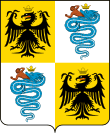 The coat of arms of the House of Sforza, featuring two biscioni and two Reichsadlers (Imperial Eagles symbolizing the German and Austrian domination over Lombardy).
The coat of arms of the House of Sforza, featuring two biscioni and two Reichsadlers (Imperial Eagles symbolizing the German and Austrian domination over Lombardy)..svg.png) The flag of the Duchy of Milan, also featuring two biscioni and two Imperial Eagles.
The flag of the Duchy of Milan, also featuring two biscioni and two Imperial Eagles.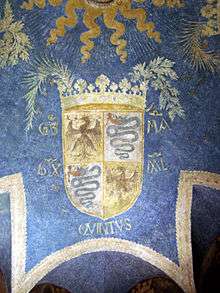 A variation of the previous: the arms of Galeazzo Maria Sforza, as inside the Sforza Castle.
A variation of the previous: the arms of Galeazzo Maria Sforza, as inside the Sforza Castle.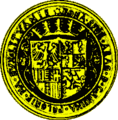 Bona Sforza's seal, bearing similarities to the other Sforza symbols.
Bona Sforza's seal, bearing similarities to the other Sforza symbols. Coat of arms of the Sforza and Caravaggio houses, as in the German-language book Wernigeroder (Schaffhausensches) Wappenbuch.
Coat of arms of the Sforza and Caravaggio houses, as in the German-language book Wernigeroder (Schaffhausensches) Wappenbuch.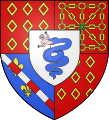 The blason of the Duchy of Montbazon.
The blason of the Duchy of Montbazon.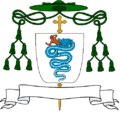 The arms of Ortensio Visconti, Bishop of Lodi.
The arms of Ortensio Visconti, Bishop of Lodi..svg.png) The coat of arms of Napoleon's Kingdom of Italy, including many symbols of Italian cities and the Imperial Eagle.
The coat of arms of Napoleon's Kingdom of Italy, including many symbols of Italian cities and the Imperial Eagle. The biscione as a symbol of Milan, seen here at its Central Station.
The biscione as a symbol of Milan, seen here at its Central Station.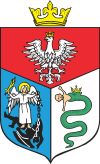 The coat of arms (the flag is very similar) of Sanok, bearing the biscione and the Reichsadler due to Bona Sforza.
The coat of arms (the flag is very similar) of Sanok, bearing the biscione and the Reichsadler due to Bona Sforza. The official seal of Pruzany (also featured in its flag), also bearing the biscione due to Bona.
The official seal of Pruzany (also featured in its flag), also bearing the biscione due to Bona. The coat of arms of the Kingdom of Lombardy-Venetia (an Austrian crown land) quartered the Biscione with the Venetian Lion of Saint Mark.
The coat of arms of the Kingdom of Lombardy-Venetia (an Austrian crown land) quartered the Biscione with the Venetian Lion of Saint Mark.
See also
References
- ↑ ERESS D. CSABA: Ugod. Száz magyar falu könyvesháza. Szerkesztette: HERMANN ISTVÁN, Megjelent a magyar állam millenniumára, Budapest. Elektronikus megjelenítés: NKÖEOK Szerkesztőség – 2007
External links
| Wikimedia Commons has media related to Coats of arms of the House of Visconti. |
| Wikimedia Commons has media related to Coats of arms of the House of Sforza. |
| Wikimedia Commons has media related to Coats of arms of Milan. |
